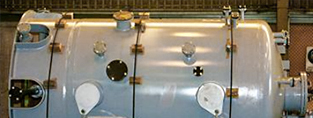
- (03) 5909 8218
- enquiry@fusionweld.com.au
What is Ultrasonic Testing in High Pressure Cylinders?
April 18, 2017

Ultrasonic technology plays an important role in countless inspection-oriented fields. Essentially, these high-frequency sound waves easily pass through soft or hard materials. Then, as they're reflected, a detailed picture of the material's innermost properties is electronically reproduced. Employed in ultrasonic testing in high-pressure cylinders, the wave-reflecting tech targets material defects and structural imperfections, the type of masked flaws that would otherwise go unnoticed.
Highlights Invisible Flaws
We choose to put the proverbial horse before the cart this time because the results of an undetected flaw require first mention. There'll be plenty of space for a technology overview in the next paragraph. Importantly, the ultrasonic tests are designed to find unnoticed flaws and material defects. These chinks in the vessel's armour are potential danger spots. Imagine a weak microcrystalline matrix, a spot on the rolled metal jacket that's presently intact. Then add the intense application stresses to this scenario. The vessel walls contract and expand under pressure. Temperature variations compound the issue. The natural flex causes a crack, a fracture that exposes hazardous materials to the local environment. At best, the environment is under threat. At worst, the pressurised fluid undergoes a state change, a dynamic chemical reaction that could end explosively.
What is Ultrasonic Testing?
Ultrasound is the answer to these microscopic and hidden flaws. Used in hospitals and civil engineering, its non-destructive testing credentials are proven. Basically, this device sees the unseen by using an electronic transducer to transmit ultrahigh-frequency sound waves into the cylinder material. The densely packaged waves are then absorbed by the material. Reflected back at different velocities and at different angles, the sound waves are subtly altered. The digital innards embedded inside the transducer-equipped device now convert these slightly altered vibrational waveforms into a picture, one that illustrates every flaw in the subject metal cylinder. In short, the thickness of the metal jacket, every microscopic flaw and potential defect is shown in sharp relief by the rendered images.
Conducted as a non-destructive inspection (NDT), ultrasonic testing in high-pressure cylinders assesses plate thickness. Uniform material thickness is then assured throughout the vessel. Next, the propagating sound waves are transmitted at an ultrahigh frequency range, so the reflecting waves are sure to create a detailed picture, one that reveals the microcrystalline structure of the vessel alloy. Like a virtual window, the transducer's display seemingly turns the vessel walls transparent so that the grain of the alloy can be certified as structurally capable. If that structural integrity is marred by a defect, then further action must be taken.
Contact Details
Fusion - Weld Engineering Pty Ltd
ABN 98 068 987619
1865 Frankston Flinders Road,
Hastings, VIC 3915
Ph: (03) 5909 8218
Optimized by NetwizardSEO.com.au
Recent Posts
- Pressure Vessel Fabrication: Engineering Efficiency for 2026 Petrochemical Projects
- Heat Exchanger Maintenance in Melbourne: Minimising Risk in Power Generation Facilities
- Compressed Hydrogen Storage Vessels: Material Selection, Design & Australian Standards
- Welding QA/QC in Oil & Gas Pressure Vessel Fabrication – Ensuring Code Compliance
- AS1210 vs ASME VIII Pressure Vessel Code: Key Differences for Australian Projects
- Mitigating Hydrogen-Induced Cracking in Pressure Vessels: Engineering and Material Strategies
- Storage Tank Solutions Australia: Field-Erected, Prefabricated & Self-Bunded Explained
- Reducing Environmental Risks: Self-Bunded Tanks in Australian Oil & Gas Operations
- Precision in Production: How Pressure Vessels Are Manufactured for Industrial Safety
- Shell & Tube Heat Exchangers: Improve Thermal Control & Energy Recovery in Petrochemical & Pharmaceutical Plants
- In-Service Inspection for Compressed Air Receivers for Power Plant Shutdown Prevention
- Power Plant Pipe Spooling Fabrication – Get Rapid, Code-Compliant Spools Ready for Installation
Posts 2026
- Pressure Vessel Fabrication: Engineering Efficiency for 2026 Petrochemical Projects
- Heat Exchanger Maintenance in Melbourne: Minimising Risk in Power Generation Facilities
- View all articles…
Posts 2025
- Compressed Hydrogen Storage Vessels: Material Selection, Design & Australian Standards
- Welding QA/QC in Oil & Gas Pressure Vessel Fabrication – Ensuring Code Compliance
- View all articles…
Posts 2024
- Large Process Vessels: Optimising the Design for Maximum Efficiency [2025]
- Pressure Equipment Management System Installation: Detect Equipment Faults Early
- View all articles…
Posts 2023
- Pressure Piping System Inspection: A Gift of Safety for the Holidays
- Deaerator Inspections by Fusion-Weld Engineering and How They Reduce System Downtime
- View all articles…
Posts 2022
- How Fusion Weld Keeps Up With AS-NZS ISO 9001:2008 Standard
- Boiler Equipment Safety Inspection During the Summer Season
- View all articles…
Posts 2021
- Avoid These Factors and Practices that Contribute to Sealing Damage in Pressure Vessels
- Do's And Don'ts Of Industrial Boiler Inspection And Maintenance From Fusion-Weld
- View all articles…
Posts 2020
- What are the Risks and Hazards Involved in Pressure Vessel Equipment?
- How to Know if Your Pressure Equipment Needs Repair or Replacement?
- View all articles…
Posts 2019
- Factors that Contribute to Pressure Vessel Failure
- Pressure Vessel Regulations in Australia: What are the Mandatory Requirements?
- View all articles…
Posts 2018
- Pros and Cons of Spherical vs. Cylindrical Pressure Vessels
- What are the Different Hazard Levels in Pressure Vessels?
- View all articles…
Posts 2017
- Transportable Pressure Vessels: The Importance of Inspection and Safety Checks
- Fracture Mechanics and Stress Analysis of Cracks in Pressure Vessels
- View all articles…
Posts 2016
Posts 2015
- What Are Deaerators & Feedwater Vessels?
- Precautions and Safety for Compressed Air Receiver Vessels
- View all articles…
Posts 2014
- Demonstrating In-process Inspection Procedures
- Static Grounding Practices and Standards
- View all articles…